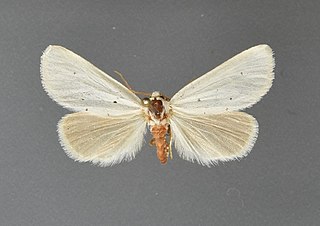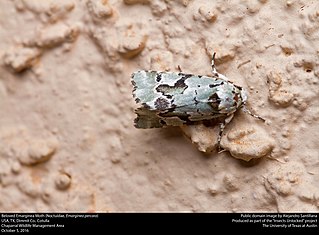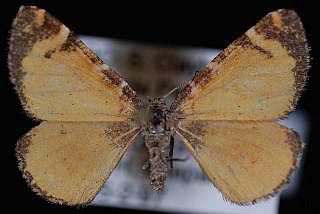
Chalcopasta is a genus of owlet moths in the family Noctuidae. There are about nine described species in Chalcopasta.
Homolagoa is a monotypic moth genus of the family Noctuidae. Its only species, Homolagoa grotelliformis, is found in North America. Both the genus and species were first described by William Barnes and James Halliday McDunnough in 1912.
Hymenodria is a monotypic moth genus in the family Geometridae erected by James Halliday McDunnough in 1954. Its only species, Hymenodria mediodentata, was first described by William Barnes and McDunnough in 1911. It is found in North America.

Grotella parvipuncta is a moth in the genus Grotella, of the family Noctuidae. The species was first described by William Barnes and James Halliday McDunnough in 1912. This moth species is found in North America, including New Mexico, its type location.
Schinia aetheria is a moth of the family Noctuidae first described by William Barnes and James Halliday McDunnough in 1912. It is found in North America, including Arizona, Nevada, New Mexico and Utah.
Idia terrebralis is a species of litter moth of the family Erebidae first described by William Barnes and James Halliday McDunnough in 1912. It is found in North America, including Illinois.
Bleptina sangamonia is a species of moth of the family Erebidae first described by William Barnes and James Halliday McDunnough in 1912. It is found in the US from Illinois and Maryland, south to at least South Carolina, but it is not present in Pennsylvania, New Jersey and Delaware.

Anhypotrix tristis is a moth of the family Noctuidae first described by William Barnes and James Halliday McDunnough in 1910. It is found from eastern Arizona and northern New Mexico southward in the Sierra Madre Occidental to the state of Durango in Mexico.
Alpheioides is a genus of snout moths. It was described by William Barnes and James Halliday McDunnough in 1912, and contains the species Alpheioides parvulalis. It is found in North America, including southern California, Arizona and Oklahoma.
Echinocereta is a monotypic snout moth genus described by Herbert H. Neunzig in 1997. The genus contains only one species, Echinocereta strigalis, described by William Barnes and James Halliday McDunnough in 1912, which is found in the US states of Arizona, California, Texas, Utah and in Mexico.
Anemosella viridalis is a species of snout moth in the genus Anemosella. It was described by William Barnes and James Halliday McDunnough in 1912, and is known from Mexico and the US state of Arizona.
Decaturia is a monotypic snout moth genus. Its only species, Decaturia pectinalis, is found from California to southern Arizona. Both the genus and species were described by William Barnes of Decatur, Illinois, and James Halliday McDunnough in 1912.
Lycomorpha splendens is a moth of the family Erebidae. It was described by William Barnes and James Halliday McDunnough in 1912. It is found in North America, including Arizona, California, Nevada, New Mexico, Texas and Utah.

Eudonia spaldingalis is a moth in the family Crambidae. It was described by William Barnes and James Halliday McDunnough in 1912. It is found in North America, where it has been recorded from Alberta, Arizona, British Columbia, California, Colorado, Montana, Nevada, New Mexico, Utah and Wyoming.
Phytometra apicata is a moth in the family Erebidae described by William Barnes and James Halliday McDunnough in 1916. It is found in North America.
Sericosema immaculata is a moth in the family Geometridae described by William Barnes and James Halliday McDunnough in 1913. It is found in North America.
Azeniina is a subtribe of owlet moths in the family Noctuidae. There are at least 10 described species in Azeniina.

Psaphidini is a tribe of owlet moths in the family Noctuidae. There are at least 40 genera and at least 90 described species in Psaphidini.
Scotogramma ptilodonta is a species of cutworm or dart moth in the family Noctuidae. It is found in North America.

Stamnodes topazata is a species of geometrid moth in the family Geometridae. It is found in North America.






